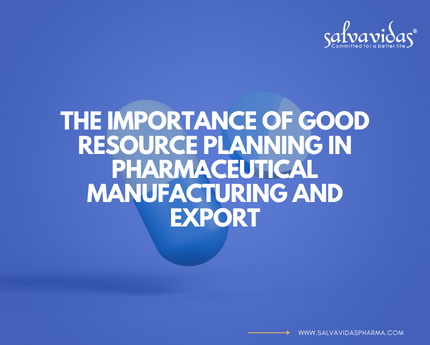
The Importance of Good Resource Planning in Pharmaceutical Manufacturing and Export
The Importance of Good Resource Planning in Pharmaceutical Manufacturing and Export
Resource planning is critical in any industry, but it becomes even more important in pharmaceutical manufacturing and export. In this highly regulated industry, managing resources effectively can be the difference between success and failure. Good resource planning can help pharmaceutical companies save time and money, improve efficiency, and ensure compliance with regulations. In this article, we will discuss the importance of good resource planning in pharmaceutical manufacturing and export.
What is Resource Planning in Pharmaceutical Manufacturing?
Resource planning is the process of identifying and allocating the resources needed to produce a pharmaceutical product. These resources can include personnel, raw materials, equipment, facilities, and time. Resource planning is crucial in pharmaceutical manufacturing because it ensures that there are enough resources to meet production demands while minimizing waste.
Why is Resource Planning Important in Pharmaceutical Manufacturing?
Resource planning is important in pharmaceutical manufacturing for several reasons. Firstly, it helps companies save time and money by identifying potential problems before they occur. By having a clear plan for resource allocation, companies can optimize their processes and reduce waste. This can lead to significant cost savings over time.
Secondly, good resource planning improves efficiency. By having a clear plan for resource allocation, companies can ensure that their processes are streamlined and optimized. This can lead to faster production times, which can be critical in the pharmaceutical industry.
Finally, resource planning is essential for ensuring compliance with regulations. The pharmaceutical industry is highly regulated, and companies must comply with strict guidelines to ensure the safety and efficacy of their products. Good resource planning can help companies meet these regulations by ensuring that all necessary resources are available and that all processes are properly documented and tracked.
How to Develop a Resource Plan for Pharmaceutical Manufacturing?
Developing a resource plan for pharmaceutical manufacturing requires careful consideration and planning. The following steps can be helpful in developing a resource plan:
Identify the scope of the project – Define the project objectives, the products to be manufactured, and the timelines for production.
Determine the resources required – Identify the personnel, raw materials, equipment, facilities, and time required for the project.
Allocate resources – Assign resources to specific tasks and determine how they will be used throughout the project.
Develop a schedule – Create a timeline for the project, including start and end dates, milestones, and critical tasks.
Monitor and adjust the plan – Continuously monitor the progress of the project and adjust the plan as necessary to ensure that the project remains on track.
Benefits of Good Resource Planning in Pharmaceutical Manufacturing
Good resource planning can provide several benefits to pharmaceutical companies, including:
Cost savings – Good resource planning can help companies save money by optimizing their processes and reducing waste.
Efficiency – By having a clear plan for resource allocation, companies can improve their efficiency and reduce production times.
Compliance – Resource planning can help companies ensure compliance with regulations by ensuring that all necessary resources are available and that all processes are properly documented and tracked.
Challenges in Resource Planning in Pharmaceutical Manufacturing
Resource planning in pharmaceutical manufacturing can be challenging for several reasons, including:
Regulatory requirements – The pharmaceutical industry is highly regulated, and companies must comply with strict guidelines to ensure the safety and efficacy of their products. This can make resource planning more complex.
Short product life cycles – Pharmaceutical products typically have short life cycles, which can make it challenging to plan for resources over the long term.
Uncertainty – The pharmaceutical industry is constantly evolving, and there is often a high degree of uncertainty around product demand and market conditions.
Conclusion
In conclusion, good resource planning is critical in pharmaceutical manufacturing and export. It can help companies save time and money, improve efficiency, and ensure compliance with regulations. Developing a resource plan requires careful consideration and planning, but the benefits can be significant. By following the steps outlined in this article and continuously monitoring and adjusting the plan as necessary, pharmaceutical companies can optimize their processes and achieve success in this highly competitive industry.
FAQs:
Q. What are the key resources required for pharmaceutical manufacturing?
Ans: The key resources required for pharmaceutical manufacturing include personnel, raw materials, equipment, facilities, and time.
Q. How can resource planning improve compliance with regulations in the pharmaceutical industry?
Ans: Resource planning can help companies meet regulatory requirements by ensuring that all necessary resources are available and that all processes are properly documented and tracked.
Q. How can resource planning help pharmaceutical companies save money?
Ans: Good resource planning can help pharmaceutical companies save money by optimizing their processes and reducing waste.
Q. Why is it important to continuously monitor and adjust the resource plan in pharmaceutical manufacturing?
Ans: The pharmaceutical industry is constantly evolving, and there is often a high degree of uncertainty around product demand and market conditions. Continuously monitoring and adjusting the resource plan can help companies adapt to these changes and remain competitive.
Q. What are some common challenges in resource planning in the pharmaceutical industry?
Ans: Some common challenges in resource planning in the pharmaceutical industry include regulatory requirements, short product life cycles, and uncertainty around product demand and market conditions.
You May Also Like

Neurology: Understanding the Complexities of the Human Brain

Health Care: A Comprehensive Guide to Promoting Well-being


0